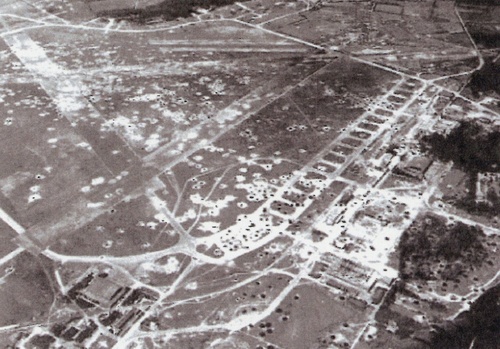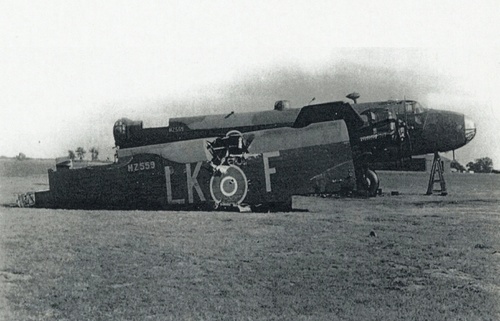Auction: 19001 - Orders, Decorations and Medals
Lot: 585
A fine Second World War D.F.M. group of five awarded to Acting Warrant Officer W. Atkins, who flew 29 operational sorties in Halifaxes of No. 578 Squadron
Most memorable of those sorties was a trip to Hanover in early January 1945, when his aircraft was severely damaged in a mid-air collision on returning from the target: displaying great calm - and even cheerfulness - as it plunged several thousand feet, he was one of the last to bale-out, delivering a sharp kick to the backside of his nervous Wireless Operator as he dithered at the escape hatch
Distinguished Flying Medal, G.VI.R. (1238624 Sgt. W. Atkins. R.A.F.); 1939-45 Star; France and Germany Star; Defence and War Medals 1939-45, good very fine (5)
D.F.M. London Gazette 17 April 1945. The original recommendation states:
'Sergeant Atkins has carried out 29 operations totalling 137.10 hours, including attacks upon such heavily defended targets as Hanover, Sterkrade, Duisberg and Cologne.
This Flight Engineer has displayed a high standard of technical ability throughout his tour and the success of his crew's operations are due to a great extent to the initiative and resourcefulness of this N.C.O. His composure in a difficult situation was particularly marked on the night of 5-6 January 1945 when, on returning from an attack on Hanover, his aircraft was badly damaged when it became involved in a collision with another aircraft. With complete coolness he stood by and advised his Captain until the aircraft with great difficulty was brought over friendly territory and the crew were able to safely bale out. Up to the last moment Sergeant Atkins remained supremely cheerful and his example on this occasion as on many others had a splendid effect upon the morale of the crew.'
The Station Commander added:
'This Flight Engineer has shown courage and determination throughout his operational tour. His work has been above average, and this is borne out by the fact that he has never been involved in a "non-starter" or "early return" due to engine trouble. His action on the night of 5-6 January, when his aircraft became involved in a collision, is particularly commendable and I recommend that this N.C.O. should be awarded the Distinguished Flying Medal.'
Walter Atkins was born on 31 March 1921 at North Windle, St. Helens, Lancashire and was employed as a glass trimmer prior to his enlistment as an A.C. 2 in April 1941.
Having then qualified as a Flight Engineer, he joined No. 578 Squadron, a Halifax unit based at Burn in Yorkshire, in June 1944 and flew his first sortie - a strike on the V-1 site located in the Forêt de Nieppe - at the end of July.
In the first two weeks of August 1941, he participated in sorties to Anderbelke, the V-1 site at Bois de Cassan, the marshalling yards at Hazebrouk, and a fuel dump in the Forêt de Mormal, in addition to further attacks on the marshalling yards at Somain and an enemy airfield at Tirlmont in Belgium.
In mid-August, the focus of No. 578 Squadron switched to Germany, beginning with a strike on the Naval Dockyard at Kiel. Two nights later, Atkins and his crew were detailed to attack a synthetic oil plant in the Ruhr, where they faced much heavy flak.
The enemy night fighter airfield at Venlo was next up on the Squadron's agenda, a daylight raid on 3 September - Atkins's aircraft was hit by flak, the crew reporting both main and tail planes damaged. Despite this, the they made it safely to the emergency airfield of Carnaby, their plight exacerbated by deteriorating weather conditions.
Following a month of rest, Atkins returned to the fray with attacks on Bochum and Duisberg. The latter, a 1000-Bomber raid on 14 October 1944, formed part of Operation "Hurricane", a joint attack by the Royal Air Force and United States 8th Air Force. The directive was clear:
'In order to demonstrate to the enemy in Germany generally the overwhelming superiority of the Allied Air Forces in this theatre … the intention is to apply within the shortest practical period the maximum effort of the Royal Air Force Bomber Command and the 8th Bomber Command against objectives in the densely populated Ruhr.'
The next day Atkins returned to Duisberg, his crew reporting, 'a mass of flames all over the target area'. On 30 October the attacked Cologne, followed by Julich, Munster, Osnabruck and the aerodrome at Essen-Mulheim; the airfield was heavily cratered and put out of action for a considerable time.
Mid-air collision - putting the boot in
The new year having opened with an attack on Oppau, Atkins and his crew were next assigned to Hanover on the night of 5-6 January 1945. Their pilot, Flight-Lieutenant Ronald Sledge, D.F.C., takes up the story:
'The outbound legs to the target area were fairly uneventful except for the usual "flak" welcome and some fighter activity in the target area. There was no trouble in identifying the target and our load of high explosive bombs was duly released.
The flight plan then called for a rapid and high-speed descent from the attack height of 21,000 down to 8,000 feet. On a reciprocal track we had completed this turn and, levelling out at 8,000 feet, allowed our speed to dissipate to normal cruising, when an urgent warning from one of my gunners was heard over the intercom to the effect that immediate avoiding action was necessary.
What happened next was so sudden that I was unable to take action of any sort. The aircraft gave a whacking great lurch. The cockpit windscreen became obscured by a large black mass of another aeroplane passing in front and what seemed only inches away from the nose. This caused my aircraft to go into a vicious downward spiral, for we were now minus a considerable section of the port wing and the outboard engine.'
It soon became clear to Sledge that there was almost non-existent aileron control. By throttling back on the port engines and applying the right rudder, some semblance of control returned, but this was only a temporary solution; the load upon his right leg soon became extremely difficult to sustain and he resorted to attaching the dinghy escape rope to the rudder pedal. As the aircraft lost height, the prospect of a crash-landing or ditching did not appear an attractive option:
'It had now got to the time when a decision had to be made as we were beginning to run out of vertical airspace. A decision to abandon the aircraft was taken. The first of the crew to exit were the two Gunners, without any trouble, followed by the Radio Operator through the front hatch. Freddie Fisher, the Wireless Operator, did not seem to relish the leap into the void below him, he was due to be married on completion of the 'tour'. It took the physical application of the Flight Engineer's boot (Atkins) on his back to propel him on his way. The Bomb Aimer and Navigator followed in quick succession.'
A fellow crew member found himself aloft a landscape which took on a fairy tale appearance due to a fresh blanket of snow. Upon landing, he stuffed his parachute under a haystack and found sanctuary in a welcoming farm cottage: '…after convincing the owner I was R.A.F., I was introduced to his wife and six children. They were delighted to accept my ration of chocolate!'
He was subsequently taken to the nearest Allied Army Unit where he was given a tot of rum and a comfortable bed for the night, which he had to share with the Navigator who arrived on the scene an hour or so later. The next morning the pair were taken to Ghent where they were reunited with the rest of the crew, all of whom had thankfully made a safe descent, albeit a chilly one; a number were somewhat footsore having lost their flying boots on the way down.
This proved to be their final sortie, all but one member of crew being decorated with either a D.F.C. or D.F.M.; the pilot of the 76 Squadron Halifax which had collided with them, Flight Sergeant Ball, R.C.A.F., managed to make a safe return to England but sadly lost his life a few days later on an operation to Worms.
Promoted Acting Warrant Officer, Atkins was demobilised in July 1946; sold with extensive copied research, including Recommendations for Honours and Awards, R.A.F. records of missions flown, and an extract from the Post Operation Report on the raid to Hanover, 5 January 1945, by Flight Lieutenant Sledge.
Subject to 20% VAT on Buyer’s Premium. For more information please view Terms and Conditions for Buyers.
Estimate
£2,200 to £2,500









